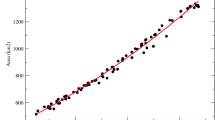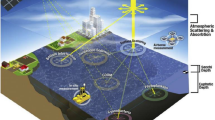Abstract
Water quality monitoring using remote sensing has been studied in Finland for many years. But there are still few discussions on water quality monitoring using remote sensing technology in support of water policy and legislation in Finland under the WFD. In this study, we present water quality monitoring using remote sensing in the Gulf of Finland, and focus on the spatial distribution of water quality information from satellite-based observations in support of water policy by a case study of nitrate concentrations in surface waters. In addition, we briefly describe instruments using a system of river basin districts (RBD), highlighting the importance of integrated water resources and river-basin management in the WFD, and discuss the role of water quality monitoring using remote sensing in the implementation of water policy in Finland under the WFD.
Similar content being viewed by others
Explore related subjects
Discover the latest articles, news and stories from top researchers in related subjects.References
Backhaus, R., & Beule, B. (2005). Effective evaluation of satellite data products inenvironmental policy. Space Policy, 21(3), 173–183.
Bloch, H. (1999). The European Union Water Framework Directive, taking European waterpolicy into the next millennium. Water Science and Technology, 40(10),67–71.
Bloch, H. (2001). EU policy on nutrients emissions: legislation and implementation.Water Science and Technology, 44(1), 1–6.
Chen, Q., Zhang, Y., Ekroos, A., & Hallikainen, M. (2004). The role of remote sensingtechnology in the EU water framework directive (WFD). Environmental Science andPolicy, 7(4), 267–276.
Dirksen, W. (2002). Water management structure in Europe. Irrgation and Drainage,51(3), 199–211.
Dworak, T., Laaser, C., Kuntz, S., & Seifert, F.M. (2005). Possible contributions ofESA global monitoring for environment and security initiative for the WFDimplementation. Environmental Science and Policy, 8(3), 321–326.
Esty, D.C., & Cornelius, P.K. (2002). Environmental Performance Measurement:Global Report 2001–2002, Oxford University Press, New York.
Gipperth, L., & Elmgren, R. (2005). Adaptive coastal planning and the European Union'swater framework directive: A Swedish perspective. AMBIO, 34(2), 157–162.
Heinz, I., Andrews, K., Brouwer, F., & Zabel, T. (2002). Voluntary arrangements tocope with diffuse pollution from agriculture and their role in European water policy.Water Science and Technology, 46(6–7), 27–34.
Kallis, G., & Butler, D.(2001). The EU water framework directive: measures andimplications. Water Policy, 3(2), 125–142.
Katko, T.S., Lipponen, M.A., & Ronka, E.K.(2006), Groundwater use and policy incommunity water supply in Finland. Hydrogeology Journal, 14(1), 69–78.
Koponen, S., Pulliainen, J., Servomaa, H., Zhang, Y., Hallikainen, M., Kallio, K.,Vepsäläinen, J., Pyhälahti, T. & Hannonen, T.: 2001, Analysis on thefeasibility of multisource remote sensing observations for chl-a monitoring in Finnishlakes. The Science of the Total Environment, 268(1–3), 95–106.
Koponen, S., Pulliainen, J., Kallio, K., & Hallikainen, M. (2002). Lake water qualityclassification with airborne hyperspectral spectrometer and simulated MERIS data. Remote Sens. Environ., 79(1), 51–59.
Kroiss, H. (1999). Water protection strategies — Critical discussion in regard to theDanube river basin. Water Science and Technology, 39(8), 185–192.
Kumpula, A. (2002). Environmental Law. In J. Poyhonen (2nd eds.). AnIntroduction to Finnish Law, Finnish Lawyers' Publishing, pp.500–555.3pt
Kuusiniemi, K. (1993). Environmental Law. In J. Poyhonen (1st eds.). AnIntroduction to Finnish Law, Finnish Lawyers Publishing, pp.345–386.
Kuusiniemi, K. (2000). Water policy and legislation in the EU- the call for anintegradted approach, Lecture Note of Nordic Research Course on Water Resources-LegalProtection and Regulation, 19–24 August, Ebeltoft, Denmark.
Kuusisto, M., Koponen, J., & Sarkkula, J. (1998). Modelled phytoplankton dynamics inthe Gulf of Finland, Enviorn. Modelling and Software, 13(5–6), 461–470.
Lindell, T., Pierson, D., Premazzi, G., & Zilioli, E. (1999). Manual forMonitoring European Lakes Using Remote Sensing Techniques, (EUR 18665 EN, OfficialPublications of the European Communities, 161 p. Luxembourg.
Luijten, J.C., Knapp, E.B., Sanz, S.I., & Jones, J.W.(2003). A role GIS-basedsimulation for empowering local stakeholders in water resources negotiations indeveloping countries: case studies for two rural hillside watersheds in Honduras andColombia. Water Policy, 5(3), 213–236.
Maia, R. (2003). The Iberian Peninsula's shared rivers harmonization of use: APortuguese perspective. Water International 28(3), 389–397.
Marjanovic, P., & Miloradov, M. (1998). Systems view of integrated water qualitymonitoring within the requirements of the new national water policy in South Africa.Water Science and Technology, 38(11), 141–148.
MoE (Ministry of the Environment): (1998). Water protection targets to 2005 (Abstractin English). The Finnish Environment, 226, FEI.
Nazarov, N., Cook, H.F., & Woodgate G. (2000). Water pollution control in anindependent Ukraine. Journal of the Chartered Institution of Water andEnvironmental Management, 14(2), 117–123.
Neal, C., & Heathwaite A.L. (2005). Nutrient mobility within river basins: a Europeanperspective. Journal of Hydrology, 304(1–4), 477–490.
Pulliainen, J., Kallio, K., Eloheimo, K., Koponen, S., Servomaa, H., Hannonen, T.,Tauriainen, S. & Hallikainen, M. (2001). A semi-operational approach to water qualityretrival from remote sensing data. The Science of the Total Environment,268(1–3), 79–93.
Quevauviller, P., Balabanis, P., Fragakis, C., Weydert, M., Oliver, M., Kaschl, A.,Arnold, G., Kroll, A., Galbiati, L., Zaldivar, J.M., & Bidoglio, G. (2005).Science-policy integration needs in support of the implementation of the EU WaterFramework Directive. Environmental Science and Policy, 8(3), 203–211.
Varjopuro, R., Sahivirta, E., Makinen, T., & Helminen, H. (2000). Regulation andmonitoring of marine aquaculture in Finland. Journal of Applied Ichtyology,16(1), 148–156.
Vihervuori, P. (1998). Environmental Law — Finland. International Encyclopaediaof Laws, Kluwer Law International, The Hague, London, Boston.
WWAP (2003). Water for people, water for life', United Nations World Water DevelopmentReport, UNESCO-WWAP.
Zhang, Y., Pulliainen, J., Koponen, S., & Hallikainen, M. (2002a). Application of anempirical neural network to surface water quality estimation in the Gulf of Finlandusing combined optical data and microwave data. Remote Sensing of Environment, 81(2–3), 327–336.
Zhang, Y., Pulliainen, J., Koponen, S., & Hallikainen, M. (2002b). Water qualitystudies of combined optical, thermal infrared, and microwave remote sensing. Microwave and Optical Technology Letters, 34(4), 281–285.
Zhang, Y., Pulliainen, J., Koponen, S., & Hallikainen, M. (2002c). Applicability ofcombined microwave and optical data for surface water quality retrievals. Journalof Electromagnetic Waves and Applications, 16(2), 249–251.
Zhang, Y., Pulliainen, J., Koponen, S., & Hallikainen, M. (2002d). Detection of seasurface temperature (SST) using infrared band data of advanced very high resolutionradiometer (AVHRR) in the Gulf of Finland. International Journal of Infrared andMillimeter Waves, 23(10), 1407–1412.
Zhang, Y., Pulliainen, J., Koponen, S., & Hallikainen, M. (2003a). Water qualityretrievals from combined Landsat TM data and ERS-2 SAR data in the Gulf of Finland.IEEE Transactions on Geoscience and Remote Sensing, 41(3), 622–629.
Zhang, Y., Koponen, S., Pulliainen, J., & Hallikainen, M. (2003b). Application ofempirical neural networks to chlorophyll-a estimation in coastal waters usingoptosensors. IEEE Sensors Journal, 3(4), 376–382.
Zhang, Y., Pulliainen, J., Koponen, S. & Hallikainen, M. (2003c). Empirical algorithmsfor Secchi disk depth using optical and microwave remote sensing data from the Gulf ofFinland and the Archipelago. Boreal Environment Research, 8(3), 251–261.
Author information
Authors and Affiliations
Corresponding author
Rights and permissions
About this article
Cite this article
Chen, Q., Zhang, Y. & Hallikainen, M. Water quality monitoring using remote sensing in support of the EU water framework directive (WFD): A case study in the Gulf of Finland. Environ Monit Assess 124, 157–166 (2007). https://doi.org/10.1007/s10661-006-9215-8
Received:
Accepted:
Published:
Issue Date:
DOI: https://doi.org/10.1007/s10661-006-9215-8




